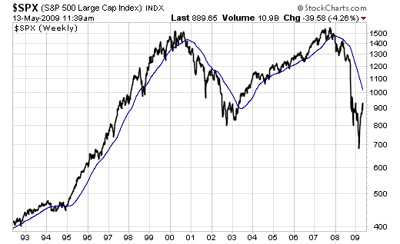子夜讀書心筆
寫日記的另一層妙用,就是一天辛苦下來,夜深人靜,借境調心,景與心會。有了這種時時靜悟的簡靜心態, 才有了對生活的敬重。This bear market is nowhere near over.
Since its March 10 low of 666, the S&P 500 has rallied more than 20%. Pundits and media commentators alike have taken this to mean that the bear market is over and that stocks should once again be the primary asset class for investors.
None of them know what they’re talking about.
Over the last 18 months, the media has been rife with “bottom callers,” all of whom have not only been wrong, but horribly, horribly wrong. In late 2007/ early 2008, Barron’s interviewed 12 Wall Street strategists. All of them thought stocks would rise in 2008. The average forecast was a 10% gain (stocks instead sank 37%).
So it’s with some concern that I noticed Barron’s latest “Big Money Poll” (a survey of 100 money managers nationwide) showed an overwhelmingly bullish skew: 60% of respondents were either bullish or extremely bullish about stocks for 2009.
Generally speaking, any time all the “experts” agree on something, the exact opposite usually comes true. And right now the “experts” believe stocks are entering a new bull market… and that the US economy is back on track.
So let’s stop for a moment and take a bird’s eye perspective of the US stock market…

The above chart shows the S&P 500 on a weekly basis going back to 1992. The blue line is the 52-weekly moving average (WMA): the most common metric for determining a bull or bear market. If the market is above its 52-WMA, it’s in a bull market. If it’s trading below its 52-WMA, it’s in a bear market.
Today, it’s clear that the S&P 500 would have to rally another 100 points (roughly 10%) before it broke above its 52-WMA and entered another bull market.
Somehow I don’t think this will happen.
Over the last 30 years, the US has built up record debts on a personal, state, and national level. Consumers thought they were financially stable so long as they could cover the interest payments on their credit cards, states created program after program, few if any of which they could afford, and the federal government issued $30-50 trillion in debt and liabilities (Social Security and Medicare).
This all came to a screeching halt when the housing bubble (arguably the biggest debt bubble in history) imploded in 2007. Since that time, stocks have staged one of their worst years on record (2008), one in five US mortgages has fallen underwater (meaning the mortgage loan is worth more than the home itself), and some $30 trillion in US household wealth has evaporated.
These issues seem to be distinct, but in reality they all stem from a debt problem. And as you know, there is only one legitimate way to deal with a debt problem:
Pay it off.
However, instead of doing this, the Feds (the Federal Reserve, Treasury Dept, etc.) have been producing even more debt. Here’s a brief recap of their moves thus far:
- The Bear Stearns deal/ the Fed takes on $30 billion in junk mortgages (Mar ’08).
- The Fed opens up various lending windows to investment banks (Mar ’08).
- Hank Paulson spends $400 billion on Fannie (FNM) / Freddie (FRE) (Sept ’08).
- The Fed takes over insurance company AIG (Sept ’08) for $85 billion.
- The Fed doles out $25 billion to the auto-makers (Sept ’08).
- The Fed's $700 billion Troubled Assets Relief Program (TARP) (Oct ’08)
- The Fed offers $540 billion to backstop money market funds (Oct ’08)
- The Fed agrees to back up to $280 billion of Citigroup’s (C) liabilities (Oct ’08).
- The Fed spends $40 billion more on AIG (Nov ’08)
- Fed agrees to back up $140 billion of Bank of America’s (BAC) liabilities (Jan ’09)
And that’s a brief recap.
In a nutshell, the Feds have tried to combat a debt problem by issuing more debt. They’re pumping trillions of dollars into the financial system, trying to prop Wall Street and the stock market. They’ve managed to kick off a rally in stocks…
But they have not addressed the fundamental issues plaguing the financial market.
I expect this rally to run out of steam any day now. When it does, stocks are primed for a re-test of their March lows. Act accordingly…




